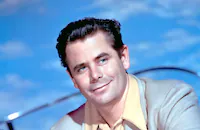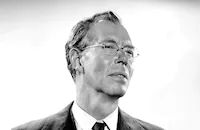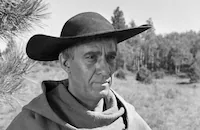Interrupted Melody

Brief Synopsis
Cast & Crew
Curtis Bernhardt
Glenn Ford
Eleanor Parker
Roger Moore
Cecil Kellaway
Peter Leeds
Film Details
Technical Specs

Synopsis
Early one morning, Marjorie Lawrence sneaks away from her family's sheep farm near Winchelsea, Australia, and catches a train to Geelong to compete in the operatic vocal competition. The following morning, Marjorie's father Bill reads in the newspaper that she has won the competition and been awarded a scholarship to study music in Paris. To the delight of her brothers and sisters, Bill lets Marjorie go with his blessing. In Paris, Marjorie is accepted as a pupil of renowned voice teacher Madame Gilly. A year later, Bill dies, and the grief-stricken Marjorie is ready to return to the farm when Madame Gilly informs the young singer that she has been selected for a production of La Bohème in Monte Carlo. Marjorie's operatic debut is a success, and she is offered a two-year contract. Overcome with emotion and lonely for her family, Marjorie meets an American, Dr. Thomas King, in the lobby of her Monte Carlo hotel. Thomas takes Marjorie out, and as they celebrate her opening with dancing and champagne, they begin to fall in love. Thomas tells her he has just completed a year's research at the Sorbonne and is about to return to the States to work at a children's hospital in New York City. After kissing passionately, Thomas and Marjorie reluctantly part so he can catch his boat.
With her brother Cyril serving as her business manager, Marjorie goes on to triumph in several major operatic roles, and is invited to perform with the Paris Opera. Soon Marjorie makes her Metropolitan Opera debut, unaware that Thomas is watching from the balcony. Thomas goes backstage to congratulate her, and although she does not recognize him at first, Marjorie arranges for him to attend her opening night party. Thomas tells Marjorie he is becoming an obstetrician, and questions her about rumors that she is engaged to Comte Claude des Vigneux. Marjorie agrees to leave her party and go for a walk with Thomas, and soon begins avoiding the Comte's calls, to Cyril's dismay. As time passes, however, Marjorie grows frustrated over Thomas' reluctance to advance their relationship, and confronts him in his office. Thomas explains that her demanding career would get in the way of a stable marriage, so it is best that they stop seeing each other.
Unwilling to give him up, Marjorie cancels her foreign engagements and assures Thomas she wants nothing more than to be his wife. They marry, and Marjorie jeopardizes her career with the Metropolitan Opera when she refuses to go on tour in Latin America to prepare for her role in Tristan und Isolde . Thomas insists that she go on tour, but refuses to leave his practice and accompany her lest he become nothing more than "Mr. Marjorie Lawrence." Later, during rehearsals, Marjorie begins to suffer from headaches, and her voice falters badly. She suddenly collapses, and Thomas flies to Latin America to be with her. Medical tests indicate that she has polio, and when Thomas visits Marjorie in the hospital, he finds her completely paralyzed. Marjorie eventually regains the use of her arms and shoulders, but her spirits remain low, and Thomas takes her to Florida to convalesce. One day, Thomas puts one of Marjorie's recordings on the phonograph and leaves the room, despite her pleas to turn it off.
In desperation, Marjorie manages to crawl over to the phonograph and knock it over before collapsing in tears. When Thomas points out that she has succeeded in moving, Marjorie at last sees a glimmer of hope. She gradually begins singing again, and secures a guest engagement with the Florida Philharmonic Orchestra, but panics and flees when it comes time to go onstage in her wheelchair. The following morning, Marjorie accidentally discovers that Thomas is struggling financially and has sold all the medical equipment in his New York office. She attempts to kill herself by taking an overdose of pills, but Thomas comes home unexpectedly and stops her. Convinced that Thomas really loves her the way she is, Marjorie urges him to return to New York alone and rebuild his practice while she remains in Florida with their maid Clara. Several weeks later, Thomas' old friend, Dr. Ed Ryson, drops by to visit. Ed, who is in the Army now, asks Marjorie to sing for the soldiers at the hospital, and as she faces the room full of injured men--many of them also in wheelchairs--she rediscovers her confidence and pleasure in singing. Marjorie goes on to entertain the troops overseas, then returns to the Metropolitan to sing in a production of Tristan und Isolde that has been staged to accommodate her handicap.
The day of the opening, Cyril calls on Thomas, who admits that he is terrified on Marjorie's behalf. That night, wearing leg braces under her costume, Marjorie performs with great poise and even manages to take a couple of hesitant steps. As Thomas watches her lovingly from the wings, an overcome Marjorie receives an enthusiastic ovation.

Director

Curtis Bernhardt
Cast

Glenn Ford

Eleanor Parker
Roger Moore

Cecil Kellaway

Peter Leeds
Evelyn Ellis

Sandy Descher

Walter Baldwin
Ann Codee
Leopold Sachse
Stephen Bekassy
Charles R. Keane
Fiona Hale
Rudolf Petrak
Claude Stroud
Stapleton Kent
Ann Howard
Donna Jo Gribble
Janet Comerford
Phyllis Coghlan
Ivis Goulding
Jean Fenwick

Doris Lloyd
Alex Frazer
Penny Santon
Phyllis Altivo
Peter Camlin
George Davis
David Leonard
Eugene Borden
Jerry Martin
Gabor Curtiz
Andre Charlot
Paul Mcguire
Doris Merrick
Jo Gilbert
Lois Kimbrille
Sandra Descher
Jack Raine
Freda Stoll
Gloria Rhods
William Vedder
Charles Evans

Martin Garralaga
William Forrest
Stuart Whitman
Bob Dix
Paul Bryar
Walter Du Cloux
Jack Grinnage

Robert Carson
Michael Dugan
Lomax Study
Edward Colmans
Anthony Merrill
Gene Roth
John Close
William Olvis
Heinz Blankenberg
Edwin Dunning
Charles Gonzales
Desire Ligeti
Marcella Reale
Armand Tokatyan
Jean Bonacorsi
Tudor Williams
Frederick Klassen
Gilbert Russell
Jeanne Determan
Joseph Gaudio
Colin Harvey
Francis Barnes
Edwin Dunning
Oliver Cross
Estelle Etterre

Bess Flowers
Edwin Tuttle
Louis Bates
Major Sam Harris
Crew
Harold Arlen
Georges Bizet
James Brock
Lew Brown
Ridgeway Callow
Salvatore Cammarano
Daniel B. Cathcart
Saul Chaplin
Marie Cowan
Jack Cummings
Adolph Deutsch
William Douglas
Walter Du Cloux
Camille Du Locle
John Dunning
Harry Edwards
Alvord Eiseman
Eileen Farrell
Harold Gelman
Ralph George
Giuseppe Giacosa
Cedric Gibbons
Sydney Guilaroff
Ludovic Halévy
E. Y. Harburg
Kurt Hernnfeld
Luigi Illica
Larry Keethe
Mollie Kent
Ferdinand Lemaire
Sonya Levien
R. Lovell
William Ludwig
Marjorie Mackay
Jay Marchant
Henri Meilhac
François Joseph Méry
Alfred Hart Miles
Wesley C. Miller
Jack D. Moore
Warren Newcombe
Jacques Offenbach
A. B. Paterson
L. Z. Phillips
Giacomo Puccini
Helen Rose
Vladimir Rosing
Joseph Ruttenberg
Camille Saint-saëns
Lady John Scott
Sam Stept
Eric Von Stroheim Jr.
Charles Tobias
William Tuttle
Giuseppe Verdi
Paul C. Vogel
Richard Wagner
Edwin B. Willis
Charles A. Zimmerman

Videos
Movie Clip





Trailer
Film Details
Technical Specs

Award Wins
Best Writing, Screenplay
Award Nominations
Best Actress
Best Costume Design
Articles
Interrupted Melody
Lawrence had published her autobiography, also called Interrupted Melody, in 1949. MGM bought it as a vehicle for Lana Turner in 1952, but Turner was deemed too lightweight for the role. Greer Garson was also considered, but she was no longer as big a star as she had been in the 1940s, and by the time the film was ready for production, she had left the studio. Producer Jack Cummings had never considered Parker for the role - he thought she was too ordinary and mild-mannered to play a diva. When Parker learned this, she stormed into Cummings' office and proceeded to display some diva temperament, telling him how the role should be played. Cummings eventually realized that Parker's flamboyant act was just that, and decided she would be fine as Lawrence. Parker, who knew nothing about opera, threw herself into the part, taking voice lessons and learning 22 arias in several languages so she would be able to lip-synch credibly. Parker recalled that she drove to work "with the score propped up on the steering wheel of my car, and I woke up at night to find I'd been repeating the songs in my sleep." According to director Curtis Bernhardt, Parker "screamed the songs. That's what probably made it look genuine. She had never seen an opera in her life." However she did it, Parker's lip-synching was perfect.
Lawrence was still very much alive when the film was made, but had retired from performing in 1952 and had turned to teaching voice. Polio had damaged her abdominal muscles, so although she was supposed to dub the vocals that Parker would lip-sync, she was no longer up to the vocal demands of singing opera. Eileen Farrell, then a well-known concert singer who had not yet made her opera debut, agreed to dub the vocals. Like Parker, Farrell was easy to work with and un-diva-like, and she insisted that she get no screen credit for her singing - she did not want to embarrass Lawrence. However, Lawrence herself went public with the information, suing MGM for not allowing her to sing the arias in Interrupted Melody. Farrell has a witty cameo in the film as a fellow opera singer who can't hit the high notes. Farrell made her grand opera debut in 1956, became one of the best-known opera singers of her era, and also one of the first to record a pop album.
Lack of familiarity with opera was not Parker's only challenge. The real Lawrence had grown up in rural Australia, and was an expert horseback rider. In fact, when she played Brunnhilde in Gotterdammerung at the Metropolitan Opera in New York, Lawrence stunned audiences in the climactic scene where her character charges into her lover's funeral pyre on horseback, one of the most famous - and challenging - moments in Wagnerian opera. Most singers would walk the horse sedately, or even get off the horse and lead it. Lawrence went into the flames at full gallop, a scene that is repeated in Interrupted Melody, with a stunt double, since Parker could not ride. A scene early in the film where Lawrence rides to the railroad station involved some trickery, because Bernhardt shot it all in one shot. As she arrives at the station, Parker's stunt double dismounts and goes behind some boxes, then Parker emerges from behind the boxes and walks towards the camera.
Interrupted Melody earned Parker some of the best reviews of her career, with such superlatives as "electrifying" and "outstanding," as well as raves for the entire production, script, directing, music, cinematography, and costumes (also Oscar-nominated). Parker earned her third Oscar® nomination for the performance, but according to Parker biographer Doug McClelland, "M-G-M chose to put its promotional clout behind four-time nominee Susan Hayward in their bigger box-office I'll Cry Tomorrow, another biography of a musical star (Lillian Roth). Both lost to Anna Magnani for The Rose Tattoo." Parker followed Interrupted Melody with another strong performance, as Frank Sinatra's shrewish wife in The Man with the Golden Arm (1955), and continued to do good work until the mid-1960s. Interrupted Melody remains a career peak, and a personal best for the talented and beautiful actress.
Director: Curtis Bernhardt
Producer: Jack Cummings
Screenplay: William Ludwig, Sonya Levien, based on the book by Marjorie Lawrence
Cinematography: Joseph Ruttenberg, Paul C. Vogel
Editor: John Dunning
Costume Design: Helen Rose
Art Direction: Cedric Gibbons, Daniel B. Cathcart
Music: Adolph Deutsch
Principal Cast: Glenn Ford (Dr. Thomas King), Eleanor Parker (Marjorie Lawrence), Roger Moore (Cyril Lawrence), Cecil Kellaway (Bill Lawrence), Peter Leeds (Dr. Ed Ryson), Evelyn Ellis (Clara), Walter Baldwin (Jim Owens), Ann Codee (Mme. Gilly).
C-106m. Letterboxed. Closed captioning.
by Margarita Landazuri

Interrupted Melody
Quotes
Trivia
The vocal student of Mme Gilly who can't seem to hit the right note, which Marjorie Lawrence can, is Eileen Farrell (I), who dubbed Eleanor Parker (I)'s singing voice in the movie's arias.
Greer Garson was originally set to play the lead role of Marjorie Lawrence, but the film was postponed for about one year. Garson wanted the part very badly and researched the role extensively. One month after she left MGM (the studio filming the movie), 'Eleanor Parker' was cast.
Notes
The film's opening credits modified the standard disclaimer to read: "But for few people, events and institutions prominent in the world of opera, all other events, characters and institutions depicted in this photoplay are fictitious..." As depicted in the film, dramatic soprano Marjorie Lawrence (1907-1979) left her native Australia for Paris in 1928, and made her professional debut in Monte Carlo in 1932. She made her Metropolitan Opera debut in 1935, and was at the peak of her career when she married Dr. Thomas King in 1941. After being stricken with polio, Lawrence entertained troops in the South Pacific in 1944, and toured occupied Europe in 1945 and 1948. Lawrence stopped performing in 1952, and became a voice instructor and director of opera workshops.
In an April 1955 article in Cosmopolitan, gossip columnist Louella O. Parsons wrote about attending a party at the home of agent Wynn Rocomora, at which Lawrence, King and actress Greer Garson were also guests. Parsons claimed that the idea for the film version of Lawrence's life was born that night, but that the project was delayed because of emergence of new technological developments, such as 3-D and CinemaScope: "The Lawrence story...had to wait until our producers found out whether the public was going to want its pictures upside down or inside out."
December 1951 Hollywood Reporter news items named Deborah Kerr, and then Lana Turner, as the star of the film, and a July 1952 news item reported that Garson would portray Lawrence. Hollywood Reporter news items add Nestor Eristoff, Dick Simmons, James Drury and Ronald Green to the cast, but their appearance in the final film has not been confirmed. Although an April 1954 Hollywood Reporter news item stated that Lawrence's voice had been recorded for the film, opera star Eileen Farrell provided the singing voice for Lawrence's character. According to an October 1954 news item in Hollywood Reporter, Joseph Ruttenberg substituted for cinematographer Paul C. Vogel after Vogel was injured in an automobile accident. Both men are listed as directors of photography in the onscreen credits. A January 1953 Hollywood Reporter news item named Wolfgang Martin as music director, but Walter Du Cloux is credited onscreen. Leopold Sachse, who portrayed himself in the film, was a longtime stage director at the Metropolitan Opera.
According to studio publicity material contained in the film's production file at the AMPAS Library, the design crew used oversized props, such as a telegram and pill bottle, so that these objects would appear normal-sized on the CinemaScope screen. Interrupted Melody received the Academy Award for Best Screenplay and was nominated for Best Actress (Eleanor Parker) and Best Costume Design (Color).

Miscellaneous Notes
Released in United States Summer July 1955
CinemaScope
Released in United States Summer July 1955














